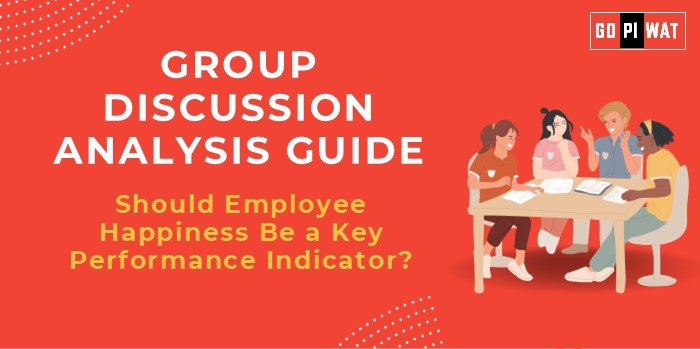📋 Group Discussion (GD) Analysis Guide
🌟 Topic: Should Employee Happiness Be a Key Performance Indicator?
🌐 Introduction to the Topic
Opening Context: “As organizations strive for growth, the relationship between employee satisfaction and business success has emerged as a critical discussion point. Progressive organizations are increasingly evaluating whether employee happiness, beyond traditional KPIs like profit margins and productivity, can drive long-term success.”
Topic Background: The concept of “employee happiness” is rooted in organizational psychology and has gained attention due to studies linking happier employees with higher retention, better productivity, and creativity. Tech giants like Google and Amazon have prioritized employee well-being as a key factor for innovation and growth.
📊 Quick Facts and Key Statistics
- 📈 Gallup Report: Companies with highly engaged employees witness 21% higher profitability.
- 📊 Harvard Business Review: Happy employees are 31% more productive and generate 37% more sales.
- 💡 Deloitte Insights: 80% of employees would consider leaving a company that does not prioritize well-being.
- 💰 Retention Impact: High employee satisfaction reduces turnover costs, which account for nearly 20% of annual salaries for mid-level positions.
- 🌍 Global Examples: Companies like Salesforce have integrated “employee happiness” into strategic KPIs, enhancing culture and reducing attrition.
🏗️ Stakeholders and Their Roles
- Employers: Evaluate policies to promote happiness and productivity.
- Employees: Play an active role in voicing needs for a balanced and fulfilling workplace.
- HR Leaders: Develop measurable happiness KPIs, integrate surveys, and analyze productivity links.
- Investors: Assess company sustainability through retention rates and organizational well-being.
🎯 Achievements and Challenges
✔️ Achievements:
- 💼 Improved Productivity: A happier workforce is 12% more productive (University of Warwick).
- ✨ Innovation and Creativity: Google’s “20% Rule” encourages employees to pursue personal projects, boosting creative solutions.
- 📉 Reduced Absenteeism: Companies prioritizing mental health report 27% fewer sick days annually.
- 📌 Higher Retention: Salesforce’s culture-based approach resulted in 25% lower attrition rates.
⚠️ Challenges:
- 📏 Subjectivity in Measurement: Employee happiness can be difficult to quantify objectively compared to traditional KPIs.
- 💸 Resource Allocation: Allocating budgets for wellness programs may divert resources from core operational activities.
- 📊 Performance Bias: Critics argue happiness may not always correlate with direct outcomes, such as revenue growth.
🌍 Global Comparisons
- 🇩🇰 Denmark: Recognized globally for the “happiest workplaces,” prioritizing work-life balance and flexible policies.
- 🏢 Google: Leader in integrating happiness-driven productivity with innovative policies.
- 📈 Case Study: Microsoft Japan’s 4-day workweek experiment boosted productivity by 40% while maintaining employee satisfaction.
🗂️ Structured Arguments for Discussion
- Supporting Stance: “Organizations that measure and enhance employee happiness often experience increased productivity, higher retention rates, and better customer satisfaction, creating a sustainable competitive advantage.”
- Opposing Stance: “Employee happiness is subjective and complex, making it challenging to align with traditional KPIs that drive tangible business results.”
- Balanced Perspective: “While employee happiness fosters a more engaged and productive workforce, it must complement—rather than replace—measurable outcomes like revenue, efficiency, and quality.”
📣 Effective Discussion Approaches
- Opening Approaches:
- 📈 “According to Gallup, organizations with engaged and happy employees report a 21% higher profitability than those that don’t.”
- 📚 “Microsoft Japan’s 4-day workweek boosted productivity by 40% while maintaining morale.”
- Counter-Argument Handling:
- 🔍 Address subjectivity concerns by suggesting frameworks like Happiness Index Surveys (e.g., Net Promoter Score for Employees).
- 🌟 Highlight global success stories like Salesforce or Google to showcase tangible benefits of prioritizing well-being.
🧠 Strategic Analysis of Strengths and Weaknesses
- Strengths: Enhanced productivity, lower attrition, improved mental health, and innovation.
- Weaknesses: Difficulty in measurement, cost of well-being programs, potential for employee complacency.
- Opportunities: Creating holistic well-being frameworks to improve sustainability and employer branding.
- Threats: Misalignment of priorities, financial pressures, subjective evaluation biases.
🎓 Connecting with B-School Applications
- Real-World Applications:
- HR frameworks focusing on employee well-being can become potential projects in management programs.
- Case studies on innovative companies like Microsoft, Salesforce, and Google can provide strategic insights for organizational leadership.
- Sample Interview Questions:
- “How can companies measure the impact of employee happiness on overall performance?”
- “Is employee happiness as critical as financial metrics for business success?”
- Insights for B-School Students:
- Employee happiness as a KPI can inform leadership styles that prioritize culture, retention, and innovation.


